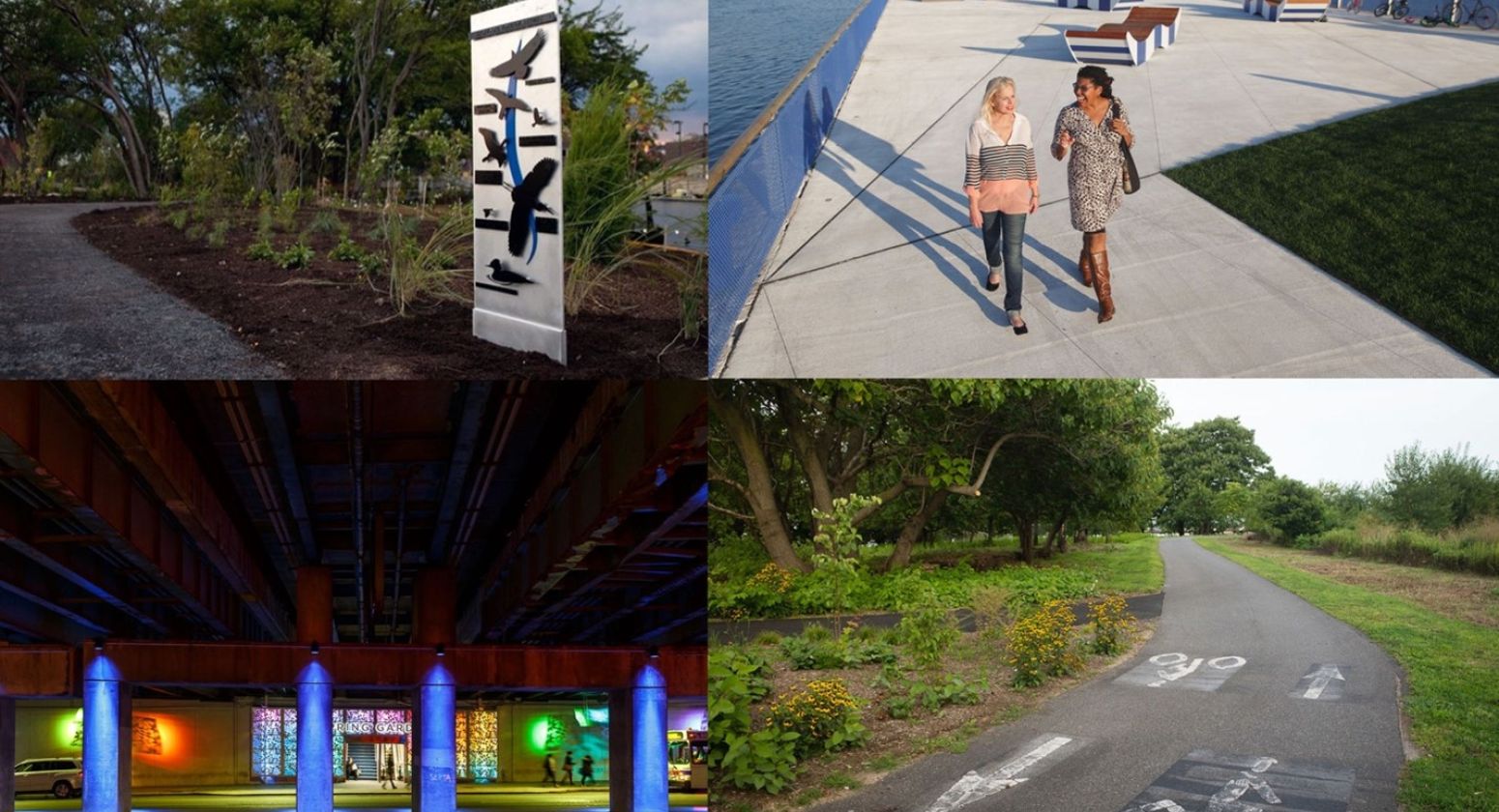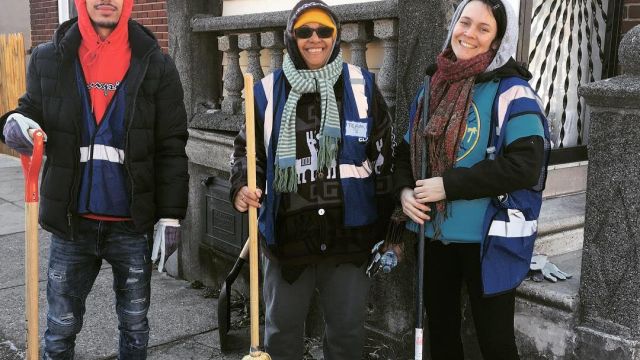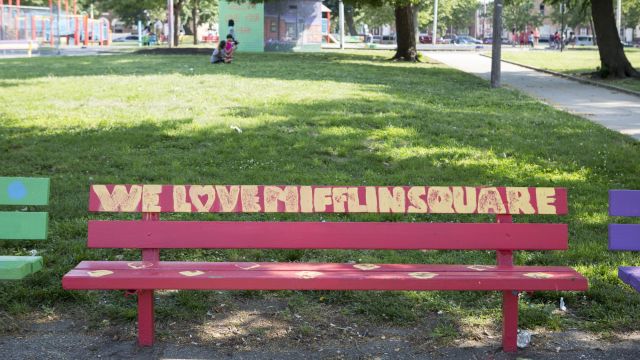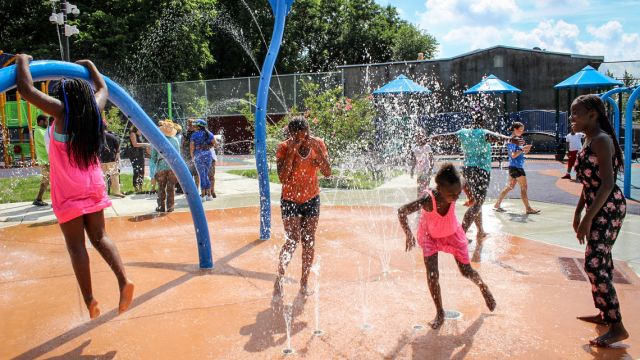Creating a World-Class Waterfront for Everyone
Creating a World-Class Waterfront for Everyone

The Delaware River is a unique natural resource, a national historical treasure, a primary source of regional drinking water, and an international shipping port. After decades of abandonment and missed opportunities, “Philadelphia’s front yard” has become a globally noted place for thriving, healthy, creative communities.
People from across the region and the world recreate in new waterfront green spaces, fish on restored piers, take their children to new playgrounds, create art in unique maker spaces, and enjoy a vast array of food, drink, arts and entertainment experiences up and down a seven-mile stretch of the riverfront. The Foundation is honored to be part of this resurgence, collaborating with the city, key stakeholders, and nonprofits to fund planning and programming that creates high-quality, inclusive public spaces.
Philadelphia’s largest waterfront greeted the 21st century in a state of disrepair and stagnation. Decades of private disinvestment and public neglect had left it underutilized, largely abandoned, and cut off from the adjacent neighborhoods.
We have long believed that the Delaware River is one of our region’s most significant assets. Dating from the 1990s, the Foundation had sought to promote the historically industrialized Delaware River waterfront as a both a natural and community resource. In the absence of a master plan and robust land-use controls, however, redevelopment proposals were ad hoc, did not take advantage of the waterfront’s unique economic and community-building potential, and in most cases never actually came to fruition. Speculative land-purchases, political scandals, and a lack of resident engagement and transparency stymied new development and left many waterfront parcels blighted and fenced-off from public access.
Unlike other blighted areas of the city, the waterfront had not historically hosted a significant residential or retail commercial presence. The sheer size of many parcels and scale of the abandoned acreage proved daunting given the city economy’s limited market potential for new residential and commercial development. And the combination of Interstate 95 and Columbus Boulevard create a 16-lane, 300-foot-wide barrier between neighborhoods and the river.
By the mid-2000s years of intensive redevelopment and population increase in the nearby neighborhoods had brought renewed attention to the waterfront and spurred new ideas about its potential. At the same time, the revitalization of the City Planning Commission by a new Mayoral administration, along with increasing calls for waterfront planning by area civic groups and public waterfront design events held by the University of Pennsylvania School of Design’s PennPraxis organization, generated public will for a renewed effort to create a world-class waterfront that could support the employment, residential, and recreational needs of Philadelphians while drawing visitors from across the region and the globe.
The Foundation supported initial planning and greening work along the North Delaware River waterfront, which showed that watershed restoration and smart redevelopment could work hand-in-hand.
The Central Delaware waterfront presented a unique opportunity because a small but highly significant portion of its overall land area was publicly owned, including dozens of acres spread across multiple piers and other parcels at the water’s edge. With the right approach and strategic support, these key public assets could host a diverse array of creative uses and experiences for people and communities across Greater Philadelphia and kickstart the revitalization of the entire waterfront area.
In late 2006, at the urging of 1st District City Councilmember Frank DiCicco, and with the active support of the Foundation, Mayor John Street issued an Executive Order establishing a comprehensive public planning and visioning process for the six-mile stretch of the Central Delaware waterfront, led by the City Planning Commission and PennPraxis.
Over the following year, more than 4,000 Philadelphians engaged in a series of innovative, interactive events that provided varied opportunities for hands-on input, from public conversations to design charrettes to mapping and priority-setting exercises, to verbal and written expressions of their values, hopes, and aspirations for this crucial part of their city.
This citizen-driven effort produced the 2007 Civic Vision for the Central Delaware, a guiding document that sought to organize riverfront redevelopment around a network of new and renovated public spaces, emphasizing enhanced transit and movement systems to and around the waterfront; supporting increased access to public parks and the conservation of ecological systems; and encouraging a rich mix of development uses. Most notably, the vision called for the extension of the street grid to the waterfront, and the connection of neighborhoods to the river.
The Civic Vision was followed rapidly by a 10-point Action Plan in 2008, and soon after by the implementation of Action Item Number One in that plan: the creation, in January 2009, of the Delaware River Waterfront Corporation (DRWC), a public-private entity charged with enhanced, more transparent oversight of publicly owned property along the Central Delaware, and with crafting a master plan that would implement the principles of the Civic Vision. The Foundation awarded funding to the DRWC to hire staff and consultants to produce the plan and – as we had done for the civic visioning process – for the provision of a robust public engagement process to ensure that the plan would reflect the wants and needs of the people of Philadelphia.
January 2009 also saw the founding of the Central Delaware Advocacy Group (CDAG), a coalition of volunteer civic associations, community groups, and mission-oriented nonprofit organizations committed to the realization of the Civic Vision in the form of a master plan. Just as the Central Delaware planning process was virtually unprecedented in its community orientation and inclusiveness, so too did CDAG broker a historic coming-together of more than 20 communities and organizations behind the unified goal of remaking the waterfront in the public interest.
In March 2012, with strong CDAG support, the Philadelphia City Planning Commission officially adopted the DRWC’s completed Master Plan for the Central Delaware into the city’s Comprehensive Plan. In June of 2013, after an intensive advocacy campaign led by CDAG, the city adopted the Central Delaware Zoning Overlay, codifying the principles of the Master Plan into legally binding provisions that govern all major aspects of new development up and down the Central Delaware waterfront.
In the ensuing decade, CDAG took on the mantle of citizen-stewards of the waterfront. The coalition grew to include several additional waterfront community associations; gained a seat on the DRWC board of directors as the two organizations partnered closely to further the implementation of the Master Plan; successfully defended the plan against multiple development proposals that would have violated its principles; and served as the community voice in a crucial multi-year rewrite of the zoning overlay that increased both its strength and flexibility as the legal codification of the Master Plan.
As we commemorate the successful conclusion of the first decade of the Master Plan – a decade in which achievements along the waterfront have exceeded even the most optimistic expectations – the Plan and its advocates continue to guide the city towards the long-term realization of a vision for a welcoming, authentic, prosperous, world-class waterfront.
To maximize the chances for meaningful transformation on the waterfront, The Foundation understood that revitalization must be inclusive at every step, enabling the public to take ownership of both the process and its results. The waterfront provided tangible, physical evidence of the true cost of neglecting good planning. The successful revitalization of such a large, significant part of the city required an equally large, significant planning process. The technical expertise of planners would not produce positive, actionable results unless the process earned broad public buy-in. Funding the planning process was about instilling public trust and confidence that something good could actually happen on Philadelphia’s Delaware waterfront, and that the outcome would reflect the values and desires of local residents and communities.
The Foundation sought a new model for public visioning that would set a standard for open access and participation in the city’s redevelopment policy decisions. Accordingly, the Foundation funded an open planning process enacted by the City and co-facilitated by the Planning Commission and the University of Pennsylvania Stuart Weitzman School of Design’s PennPraxis organization. The year-long process engaged more than 4,000 Philadelphians, ultimately culminating in a 2011 master plan that has spurred a decade of waterfront revitalization and is designed to guide efforts for another 20 years.
Beyond planning, the Foundation has supported design studies with integral public engagement components, as well as maintenance, outreach, and programming initiatives to ensure that waterfront spaces became welcoming, highly valued places used and enjoyed by people from now and far into the future.
Progress to Date
Since 2007 the Foundation has invested $30 million in planning, projects, and initiatives up and down the Central and North Delaware River waterfronts. During this time we have supported the planning and development of more than 20 new and revitalized waterfront parks, piers, green spaces, playgrounds, and connector streets; internationally renowned destinations like Spruce Street Harbor Park; an ongoing and comprehensive waterfront arts program; and a waterfront trail extending along a seven-mile span from South Philadelphia to Northeast Philadelphia. The result has been a marked improvement in waterfront access, the number and quality of public waterfront spaces, and the pace and quality of private development spurred by this new public infrastructure.
Just as important, we have continued to deploy funding resources to promote robust community engagement in planning and redevelopment, and inclusive programming and promotion of waterfront sites and amenities. Philadelphians have embraced their emerging new waterfront, claiming pride and ownership in it, and patronizing it in numbers unimaginable only a decade ago.
What We're Learning
The main overall lesson of our work along the waterfront can be summarized by the final and most memorable recommendation of the first document that merged from the public planning process, the 2007 Civic Vision for the Central Delaware: “Keep it real, Philadelphia.” But from the Foundation’s perspective, the most important learning for us as an organization is the value of sustained community engagement and advocacy. The community advocacy and engagement associated with this initiative has provided continuous public support for over a decade, enabling the Vision to survive three mayoral transitions and continue to make progress toward full implementation over the span of many years. As WPF’s Executive Director, Shawn McCaney, who oversaw the early planning work has often commented, “Our ultimate aim wasn’t to create a better plan for the waterfront; our aim was to create a client and public demand for a better plan.”
Creative communities emerge organically, and for waterfront projects to flourish they require integral community participation from the very first conceptual designs, through to post-completion stewardship and usage. The 2011 Master Plan for the Central Delaware calls for each of the public parks approximately every half-mile along the waterfront to be distinctive, tailored to its local environmental conditions, existing infrastructure, and neighborhood fabric. For these spaces to be successful, they must respond to community needs, feel authentic to neighborhood residents, and be open and welcoming to people from all backgrounds. We have seen this important process unfold over the course of a decade. It started with Race Street Pier in Old City, constructed as a formalized public park abutting the Columbus Boulevard frontage, which accommodates socializing, leisure activities, weekly yoga classes, and much more.
By contrast, Pier 53 South, near Washington Avenue in South Philadelphia, is embedded in a lush green environment along the water line, and contains exposed former pier supports as part of a watershed reclamation project, as well as an observation deck marking the site of a major immigration port in the 19th and early 20th centuries. Along with other nearby piers like Pier 68 south, it affords opportunities for fishing, bird-watching, and other environmentally rich activities. The most recently completed pier space, Cherry Street Pier, features the renovated skeleton of an industrial warehouse structure and houses a 24/7 art-studio and creative-maker community, along with periodic farmers markets and events. In March 2022 construction began on a public pier amenity that will carry Spring Garden Street in Northern Liberties to the water’s edge as part of a nine-acre mixed-use commercial-residential development project.
From these projects, we and our partners have learned that public engagement must be practiced at every turn, and the trust and sense of ownership it engenders must be continually nurtured and renewed. In addition to appealing to local residents, the design, amenities, programming, and overall place-making of these sites must be inclusive. To that end, the Foundation has funded the voluntary collection of visitor demographic information to better understand who frequents these spaces, how they feel about them, and how we might address potential barriers to full usage by the most diverse possible populations. This data has been used to inform and guide the development of new riverfront programming and improvements.
To address the crucial problem of the I-95/Columbus Boulevard barrier, the Foundation coordinated with the Delaware River Waterfront Corp., city, state, and federal agencies, and other private funders to support the design and creation of a 12-acre park that will cover the highways between Chestnut and Walnut streets. The I-95 park cap represents the culmination and centerpiece of long-term efforts to improve public access to the riverfront and restore the pedestrian connection between the city’s historic district and the waterfront that was severed with the construction of I-95. The Foundation provided the first publicly announced funding, $15 million, to enable the creation of high-quality landscape, hardscape, and public amenities in the park.
The project has been meticulously engineered to enable the restoration of clear pedestrian sightline paths to the water, which have been blocked ever since the construction of I-95 half a century ago. The park will host extensive new green infrastructure and a wide variety of public recreational amenities and serves as the catalyst for more than $2 billion in new private development immediately to the north and south, slated to break ground in the late 2020s. The result will be a beautiful, accessible, multi-use space that will activate Penn’s Landing like never before, bring in thousands of new residents, generate thousands of jobs, and generate an estimated $5 economic return to the city for every dollar invested in the cap project.
In 2017 and 2018 the Foundation awarded $750,000 to support a civic engagement-based planning process for a new 10-acre park on the Delaware River in the Bridesburg neighborhood. Half of the park will enhance an existing raised meadow to support indigenous ecology, while the other half will host a playground, picnic area, stage, and boardwalk overlook. In addition to supporting conceptual planning shaped by the community’s experiences and vision, the Foundation dedicated funding to mobilize and strengthen community investment in the park and the watershed, supporting the creation of a neighbor advisory council that will become a friends-of-the-park group when the project is completed. In 2019 the Foundation granted $2 million to Riverfront North Partnership for construction, which is ongoing in cooperation with the City of Philadelphia Parks and Recreation Department. Phase One of the park opened in 2021, with Phase Two expected to be completed in 2023.
In 2019 the Foundation funded a conceptual design process for stabilizing the waterfront site of an abandoned, crumbling railroad coal bridge in the Port Richmond section of Philadelphia. In recent decades the site, known as Graffiti Pier, has become an internationally known and beloved center for an ever-changing gallery of street art. The Foundation’s support funded a unique conceptual design process that engaged both neighborhood residents and the local community of graffiti writers. Through community meetings, informal meetups, private conversations, and an informal fan magazine called Voices of Graffiti Pier, a vision emerged of a renewed site that maintains the authentic, organic character of the present site while stabilizing it structurally and accounting for a future of rising tides.
Tying key public space amenities together and creating new pedestrian and bike connections between communities along the riverfront is the new Delaware River Trail. A 3.3-mile section, completed in the spring of 2022, links Pier 70 near the south end of the Central Delaware Riverfront to Penn Treaty Park in the north. The Foundation was a major supporter of the trail, which is the first multi-modal trail in the city that safely separates bike and pedestrian movements.
The trail includes two miles of curb-separated, bi-directional asphalt bike path separated from a sidewalk for walking and running; landscaped planting beds that provide safe buffers between different modes of traffic and that include hundreds of new trees and beautiful, seasonal shrubs and grasses; solar-powered pedestrian light poles; original artworks and distinctive furnishings, including benches, bicycle racks (including a two-tier bicycle shelter at Spruce Street Harbor Park), trash and recycling cans; a bicycle and pedestrian counter at Spruce Street Harbor Park depicting monthly and yearly numbers of cyclists and pedestrians; and enhanced stormwater management through new inlets and strategically-located rain gardens
Progress Timeline







More Creative Communities Stories

Meaningful Community Engagement
Learn More
The Importance of Public Space Maintenance: How Philly is Meeting an Existing Need
Learn More


